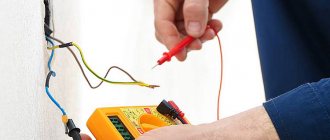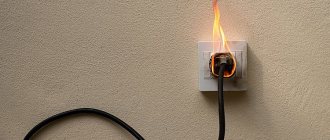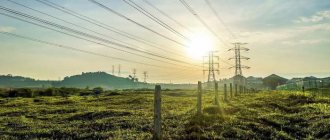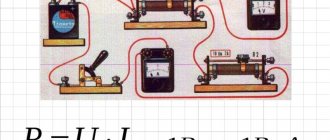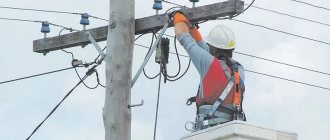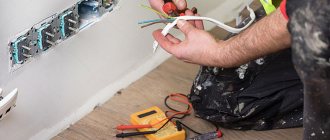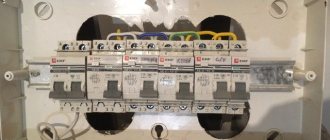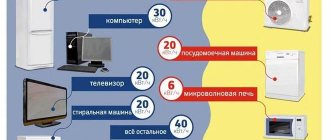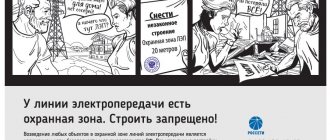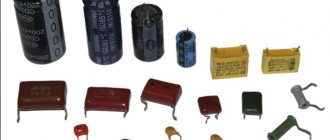Wind is an unpredictable and inexhaustible source of energy. People have been trying to use this source of energy as “fuel” for a long time. Essentially, a wind turbine at home produces wind “fuel,” but it is difficult to control. To extract wind “fuel”, you will initially have to take care of protecting the production system. Let's imagine a gas generator without a throttle valve. At any moment such a generator is capable of stopping, and at any moment it is capable of spinning up to incredible speed. So, is there any point in wind energy for a home in the context of a complete refusal of centralized energy supply? Let's try to analyze the controversial topic of home wind energy.
Main characteristics
As with any technical device, so with an air turbine, the parameters that classify its capabilities, as well as providing information about a particular model, are its technical characteristics.
The main technical characteristics for such devices are:
- Rated output power, measured in kW.
- The rated rectified voltage that the generator produces at a certain rotor speed of the installation.
- The frequency of the generated voltage, measured in Hz.
- The rotor rotation frequency, in operating mode, at which the rated rectified voltage is created. Measured in revolutions per minute.
- The rated speed at which a wind turbine meets its declared power. Measured in revolutions per minute.
- Stealth speed is measured in revolutions per minute and classifies the maximum ability of the unit to operate at a certain speed.
- An operating mode in which a particular device model is capable of operating for a specified time (long-term, cyclic, short-term, etc.).
- The level of noise (sound) produced during operation of a particular model is measured in dB.
- Device efficiency.
- Type of cooling of components and mechanisms.
- Method of installation and assembly.
- Dimensions.
- Unit weight.
Conclusions and useful video on the topic
How the source data is analyzed and how the formulas are applied is presented in the video:
It is necessary to use calculated data in any case. Whether it is an industrial power plant or one manufactured for domestic use, the calculation of each unit always ensures maximum efficiency of the device and, most importantly, operational safety.
Preliminary calculations determine the feasibility of implementing the project and help determine how costly or economical the project is.
Do you have experience in solving similar problems? Or still have questions on the topic? Please share your wind turbine calculation and design skills. You can leave comments and ask questions in the form below.
Design features of a wind turbine
Wind generators equipped with a wind turbine are a cylinder with blades inside. The presence of an external contour around the blades provides them with protection from foreign objects and living organisms getting into them.
The absence of the need for a tail section (for orientation relative to the wind direction) reduces the weight and dimensions of the device, and also facilitates installation and operation. The body, in the form of a cylinder, is independently oriented in the direction of wind flows, and, essentially working as a nozzle, increases the pressure on the installed blades, thereby increasing the efficiency of the wind generator.
Advantages of wind generators
Wind power plants have been used for a long time in everyday life, in production and other areas.
During this time, it was possible to identify their main positive qualities and advantages:
- The wind energy used for wind farms is free and, most importantly, renewable. The devices do not pollute the environment and do not emit any harmful substances. In the future, it is planned to use environmentally friendly wind power plants in Russia even more widely, which will reduce the number of conventional installations with harmful emissions.
- The dependence of power supply through central electrical networks is reduced.
- Broad prospects for further development and implementation of new progressive technologies, and these are not the last advantages of these installations.
- Gradual reduction in energy costs, which cannot be avoided at the initial stage. Over the past 20 years, the cost of equipment and components has decreased by approximately 80%. Wind energy is becoming the most profitable among all alternative sources of electricity.
- Wind turbines have a fairly long service life of 20-30 years. During this period, the surrounding landscape remains undamaged.
- Easy to assemble and further use. A wind power plant can be installed very quickly, and repair and maintenance costs are relatively low. The generated electricity quantitatively exceeds the expended wind energy by approximately 85 times. Losses during electricity transmission are relatively low.
How to calculate correctly
The main indicator that determines the choice of a particular model is the ability to generate electrical energy, which is measured in kilowatt hours per unit time.
The amount of energy generated is directly related to the power of the installation, which is the main technical characteristic of the unit, therefore the calculation of the wind turbine determines its geometric dimensions, the number of installed blades and the installation height above the ground.
The power of the electric generator, which determines the ability of a wind turbine to generate electric current, depends on the wind flow, the power of which, in accordance with the efficiency of the turbine, can be calculated using the formula:
P=KxRxV3xS/2
Where:
P – air flow power;
K – coefficient taking into account the efficiency of the turbine, has a value from 0.2 to 0.5 units;
R – air density, is 1.225 kg/m3 (at normal atmospheric pressure);
V is the speed of air flow, measured in m/s;
S – coverage area of the wind turbine (wind flow operating with the installation).
From the above formula it is clear that the power of the wind flow, and, consequently, the power of the generator, directly depends on the diameter of the wind turbine (S= π R2).
Knowing the speed of air flow at the installation site and its diameter, it is possible to determine the power of the installation and its ability to generate electrical energy.
Types of Wind Generators
When classifying wind turbines, the following characteristics can be taken into account:
- appointment;
- design features;
- number of blades;
- the materials from which they are made;
- axis of rotation;
- propeller pitch.
Let's take a closer look at the two most commonly used classifications.
Classification of wind generators by purpose
There are types of wind turbines that differ in purpose. The main characteristics of devices, for example, power, depend on this.
Industrial wind turbines
Such devices are installed by large energy companies or the state to supply electricity to industrial facilities. Turbines, with a capacity of tens of megawatts, are usually located in wind areas (open hills, coasts).
Wind farms, where dozens of wind turbines are installed, are located not only on land, but also in shallow water. The resulting electricity is usually used for industrial purposes
The generated electricity, as a rule, goes directly into the network, while for stability and regulation of the speed of rotation of the blades, wind turbines are equipped with additional mechanisms.
Commercial Wind Generators
Such installations are used to generate electricity for sale or to provide electricity to production in regions with a low-power electrical network (or no electricity grid at all). Such wind power plants consist of a cluster of electric generators, which can have different capacities.
Energy from commercial installations can be fed directly into electrical utilities or used to charge a large array of batteries, where it is stored and converted to feed the grid.
Household wind devices
Low power units are used for private use. According to the rules, wind turbines with masts less than 25 meters high can be installed by land owners without approval from the authorities; for higher masts, special permission must be obtained.
Windmills of low and medium power can serve as a source of electrical energy for cottages, dachas, country houses, and farms
Household wind generators are suitable for charging batteries with a voltage of 12/24/48V, the energy from which is transformed into a voltage of 220 Volts. Such devices make it possible to completely or partially solve the problem of power supply to small objects that are located far from the centralized power grid.
Types of wind turbine designs
Based on their design features, devices can also be divided into a number of categories, although all varieties come down to two main types: vertical and horizontal.
Classic horizontal wind turbines
Such installations (they are also called propeller or wing) usually have 3-5 blades mounted on a horizontal axis. Rotating at high speed, such elements allow you to obtain the maximum amount of energy (KIEV up to 0.4).
Moreover, the amount of electricity generated largely depends on the height of the device (the higher it is, the greater the result).
A horizontal wind turbine uses lift, which occurs when pressure increases at the point where direct air flow passes through the blades and is reflected from these elements.
These devices are typically installed in wind farms where energy is generated for industrial and commercial use, but they are also suitable for domestic use.
An interesting solution for a horizontal windmill is a model with one blade; the following selection of photos will familiarize you with its features:
Vertical wind turbines
The operating element of such installations is a rotating wind wheel. Due to their design features, such structures differ by type (“Barrel”, “Savonius”).
The following photo selection will introduce you to the principle of the Savonius vertical generator turbine:
Despite the low KIEV index (0.1-0.2), they are widely used: vertical installations operate on turbulent air flows, so they can be placed even in areas where strong winds rarely blow.
The operation of vertical wind generators does not depend on the direction of the winds. They are easy to install and operate, and such devices can be installed close to the ground
To improve the efficiency of vertical wind turbines, manufacturers often increase their dimensional parameters, which leads to a significant increase in cost. Since such installations are quite fragile, they require increased protection from hurricanes and other natural phenomena.
Wind generators "Rotor Daria"
Such devices belong to the category of vertical wind turbines, but have pronounced differences in design. Thanks to such features, noise reduction is achieved, and KIEV also increases, which approaches the performance of horizontal models.
A low-pressure turbine with an axis of rotation perpendicular to the air, proposed in 1931 by the French aircraft designer Georges Darrieus, has found wide application in wind energy.
The disadvantage of such designs is the low starting torque (due to the presence of only two blades, it is difficult for the device to start on its own). To solve the problem, the “Savonius + Darier” hybrid is often used.
Sailing wind installations
For such installations, the principle of constructing both vertical and horizontal wind turbines can be used. The main design feature is a wind wheel covered with many blades or sails, while such models do not have an aerodynamic profile.
There are many models of sail wind generators, which differ in the number of blades, weight, and power. All these parameters should be taken into account when choosing a device
Despite the fact that sailing installations are characterized by low speed and low efficiency, they are often used in the national economy. Such designs are easy to install and operate, and the combination of high torque and low speed allows you to directly drive various useful mechanisms, for example, a pump for pumping out water.
The following gallery will introduce you to one of the models of sailing wind turbines implemented in practice:
Types of wind turbines
Although it was initially believed that a wind installation with a wind turbine involves its installation only in a horizontal plane, which characterizes wind generators with a horizontal axis of rotation, nevertheless, designers have developed new versions of such devices, which are:
Vertical axis wind turbine
In installations of this type, the turbine cylinder is located vertically, and the blades are in a plane perpendicular to the surface of the earth.
The operation of wind turbines with a vertical axis of rotation is similar to the operation of devices with a horizontal axis of rotation.
Wind turbine without blades
The presence of blades in wind turbines of various designs leads to the fact that their installation requires significant areas, even if these are wind turbines located in a rigid casing. In this regard, a new direction in the development of wind turbines has been the construction of similar devices using wind turbines that do not have blades.
This design consists of a pillar with metal disks inside. The discs are mounted on the shaft and located parallel to each other, with special gaskets installed between them. When air hits the gaskets, they begin to move and give a certain and directed impulse to the metal disks, under the influence of which the disks begin to rotate. Under the influence of the rotational movement of the disks, the rod begins to rotate, which in turn transmits its rotational motion to the generator shaft.
Wind turbine for roof
Interest in the ability to provide oneself with free electrical energy, without creating problems for others, even in a city, led to the development of a wind turbine design that can be installed on the roof of any building.
Such an installation has small overall dimensions, light weight, and is practically silent during operation. The outer body of the device is made in the form of a snail, which allows you to increase the wind flow in the desired direction and orient yourself in space in accordance with its direction.
Wind generator device
Various versions of wind generators differ significantly from each other.
The diagram below shows the internal structure of a classic horizontal wind generator. Such models are most often used both in industry and in everyday life.
Industrial devices are a complex multi-meter structure, the installation of which requires a foundation, while a household model can consist of a minimum of components (DC electric motor 3-12V, electric capacitor 1000 uF 6V, silicon rectifier diode).
A typical installation includes the following components:
- alternating current generator (power depends on the speed of wind flows);
- blades that transmit rotation to the generator shaft (often they are additionally equipped with gearboxes and rotor speed stabilizers);
- the windmill mast to which the blades are attached (the higher these elements are, the more wind energy they can receive);
- batteries that store energy, allowing it to be used when there is little or no wind flow. The battery also performs the function of stabilizing the electrical energy supplied from the generator;
- controller - converter of alternating voltage received from the generator into direct voltage, which is used to charge the battery. The controller is controlled by turning the blades, which allows you to take into account where the air flows are moving;
- AVR is an automatic switching device that connects the wind generator with other energy sources (solar panels, power grid);
- wind direction sensor - a device that makes it easier for the blades to find the wind flow;
- an inverter for converting direct current from batteries into alternating voltage, which is used in electrical communications.
To better meet user needs, the device can be equipped with various types of inverters:
- devices with an inverter-modified sine wave that produces a square sine wave. Devices of this type are suitable for heating elements, incandescent lamps and other devices that are undemanding to network quality;
- three-phase voltage inverters designed for three-phase electrical networks;
- pure sine wave units that produce energy for more sensitive equipment;
- network inverters that can operate without batteries. Such devices are designed for circuits that involve electrical energy entering directly into the general network.
When choosing models, be sure to pay attention to the type of inverter.
Popular models and brands
Among the variety of wind turbines produced in different technically developed countries, the most popular are the following:
- The turbine, developed by specialists from F iddler (USA), is intended for individual use and involves installation on the roof of a residential building or other structure for individual use.
This model is equipped with an electronic unit, with the help of which, using special mobile applications, it is possible to control the operation of the device at a remote distance.
The wind turbine works in tandem with a battery installed inside the building . Fastening elements require installation on the roof ridge, which increases the amount of wind flow captured by the turbine. The noise level during operation of the device is kept to a minimum, which makes it possible not to create discomfort for residents living inside the building on which the unit is mounted.
The turbine model “Liam F1” was developed in Holland by The Archimedes, is lightweight (up to 80.0 kg) and is intended to be installed on the roof of a building or other free-standing support. The design of the receiving unit, in the form of a snail, allows you to increase the efficiency of the wind turbine and always be in the plane of movement of wind flows.
The noise level during operation is very low, which allows installation in any convenient place.
Design and types of wind power plants
Wind power plants (WPPs) use wind energy to generate electricity. Large stations consist of many wind generators, united into a single network and powering large areas - towns, cities, regions. Smaller ones are capable of providing small residential areas or individual houses. Stations are classified according to various criteria, for example, by functionality:
- mobile,
- stationary.
By location:
- coastal
- offshore
- ground
- floating.
By type of construction:
- rotary,
- vane.
Vane stations are the most widespread in the world. They are highly efficient and capable of producing large enough amounts of electricity to supply consumers throughout the entire energy industry. At the same time, the distribution of such stations has a specific configuration and is not found everywhere.
Average prices
Equipment used in alternative energy, including wind turbines, is not cheap. This is due to the fact that, as a rule, new models are produced in single-piece versions, and what has already been supplied is not sold en masse, which is due to the fact that this method of generating energy has not yet found widespread use among users.
The cost of the above installations is:
- The “Liam F1” model is sold in the European Union and America, its cost is from 4000.0 euros.
- There is no data on the cost of the model from the American company Fiddler, but due to its configuration and the supply of similar devices on the market, we can confidently say that the installation price is no lower than that of Dutch developers.
Economic justification for the construction of a wind farm
From an economic point of view, the construction of a wind farm makes sense only in the absence of other methods of energy supply. The equipment is very expensive, maintenance and repair require constant costs, and the service life is limited to 20 years, and this is in European conditions. For Russia, this period can be reduced by no less than a third. Therefore, the use of wind power plants is economically ineffective.
On the other hand, in the complete absence of alternative options or in the presence of optimal conditions that ensure high-quality and uniform operation of wind turbines, the use of wind farms becomes a completely acceptable way to supply energy.
Important! We are talking specifically about large stations that supply entire regions. The situation with household or private stations looks more attractive.
Advantages and disadvantages
The simplicity and reliability of wind generators made using a wind turbine are not the only advantages of these units. In addition, the advantages of using wind turbines include:
- Ability to work in low wind flows, with a speed of 2.0 m/s.
- High sensitivity to wind currents.
- Ability to work at strong, hurricane speeds of air flows, up to 60.0 m/s.
- With the same overall dimensions, a wind generator equipped with a turbine has more power and higher efficiency compared to bladed units.
- The turbine is a safe technical device for the animal world that lives in the place where the unit is installed (birds, bats).
- When the turbine operates, infrasound is not produced, which is harmful to humans and animals.
- Lower cost compared to blade designs.
- Ease of installation work due to the assembly of the main elements in the factory.
- Simplicity and ease of maintenance.
- Long service life.
The disadvantages of such devices are:
- Wind is an atmospheric phenomenon that is beyond human control, so it is impossible to predict, over a long period, the strength of its flow and direction of movement;
- Due to the variability of the strength of the wind flow, it is necessary to provide significant electrical capacities for storing the generated energy;
- High cost of a set of equipment;
- Before installing high-power wind turbines, it is necessary to calculate the economic feasibility in connection with the wind map of the selected region.
Private wind farms
For Russia, the most pressing issue is the distribution of small stations that supply one house or estate. The construction of large wind farms in the climatic conditions of our country is impractical and unprofitable. The greatest value of wind turbines lies in the ability to provide energy to backward or remote communities where there is no grid connection.
For such areas, the use of small private stations is the best way to solve the problem, since the operation of a wind turbine does not require the provision of fuel, the device is simple and can be easily repaired. Providing such regions with additional equipment is much easier and cheaper than allocating large amounts of money for power transmission lines, especially when it comes to mountainous areas. Small wind turbines can generate a sufficient amount of energy without the need for maintenance or fuel costs, making them a very promising and attractive solution to the problem.
Where can I buy
A wind generator, and accordingly a separate element from this installation, which is a wind turbine, is a specific product. Therefore, it is best, if you want to purchase such equipment, to contact a company that specializes in the implementation of just such installations.
Choosing such an organization will allow you to avoid mistakes when selecting the required model; in addition, specialists will be able to provide assistance with the installation and subsequent maintenance of the purchased unit.
In addition, you can use Internet resources, where a wide range of companies are presented that offer products for sale in this particular segment of devices, but these are usually products of Chinese manufacturers, the quality of which has many complaints. In addition, when purchasing complex equipment, such as wind turbines, via the Internet, there is no opportunity to return low-quality goods and receive qualified assistance.
Capacity of industrial stations
Industrial wind farms have very high power, capable of supplying large settlements or regions. For example, the Gansu wind farm in China has 7965 MW, Enercon E-126 produces 7.58 MW , and this is not the limit.
It should be noted right away that we are talking about leaders in wind energy; other models produce much less energy. However, when combined into large stations, wind turbines are capable of producing quite a sufficient amount of electricity. The combined complexes generate a total power of 400-500 MW, which can easily be compared with the productivity of hydroelectric power stations.
Small stations have more modest indicators and can only be considered as point sources that supply a limited number of consumers.
How to make it yourself
Due to the fact that it is quite difficult to make a wind turbine located in a closed space (cylinder), this is done by professional designers and engineers, you can make a turbine for a wind turbine with a vertical axis of rotation with your own hands, using improvised means.
To do this you will need the following materials:
- A pipe made of durable plastic of the largest diameter, from what is available.
- Sheet plywood with a thickness of 10.0 - 12.0 mm;
- Wood screws;
- Metal pin with a diameter of 12.0 – 16.0 mm;
- Nuts and washers corresponding in diameter to the existing stud;
- Car hub, complete with bearing.
and tool:
- Cutting tools: hacksaw, grinder with cutting wheels, jigsaw, knife;
- Grinding tools: grinder with grinding wheels, files, sandpaper;
- Set of wrenches and screwdrivers;
- Screwdriver.
The design that should be obtained as a result of the work done, and the diagram of its operation, are presented in the diagram below:
- The work is performed as follows:
- A blank is made from an existing pipe; for this, the pipe is cut to the required length (about 1.0 meters), after which it is cut along its axis. The result is 2 equal in length and length of the arc, halves.
- Plywood blanks are installed inside the pipe blanks, at the top and bottom of each of them. Fastening will be done using self-tapping screws. The result is two half-barrels.
- The resulting half-barrels are connected to each other in such a way that they overlap one another. In addition, in places of overlap, it is necessary to select a segment (not shown in the diagram) so that they seem to fit inside each other. The depth of the selected segment is at least 50.0 mm, the length can be arbitrary.
- 2 circles with a diameter of 100.0 mm are cut out of plywood, which are also secured with the help of frosts at the top and bottom of the half-barrels being connected. The result is a rigidly connected structure.
- In the middle of the resulting imaginary circle, and this should be the point where the segments are selected (on top of the fixed plywood circles), a hole is made in accordance with the diameter of the existing pin. Holes are made in the upper and lower parts of the workpieces.
- A pin is inserted into the holes, which is secured in the assembled structure by installing washers and nuts.
- For an existing automobile hub, a sleeve is made in accordance with the inner diameter of the bearing and the diameter of the stud. The bushing is pressed into the bearing, after which a pin is put on it, which is additionally secured with nuts.
Two circles are cut from plywood, in accordance with the diameter of the pipe, after which, according to their diameter, they are divided into two parts. The result is four blanks in the form of a semicircle.
For complete readiness of the wind installation, it is necessary to install a pulley on the stud below the location of the hub, through which the rotational movement from the turbine will be transmitted to the electric generator, and install the assembled turbine in the place chosen for installation.
